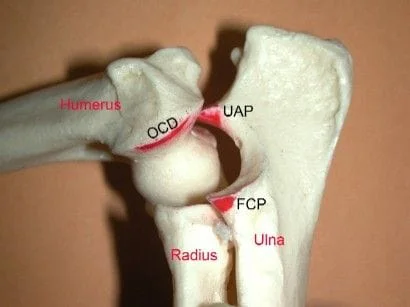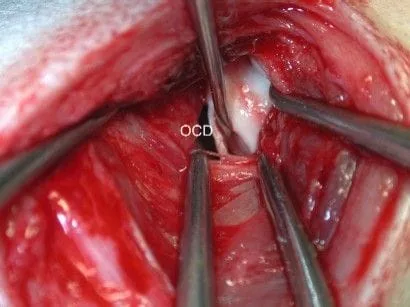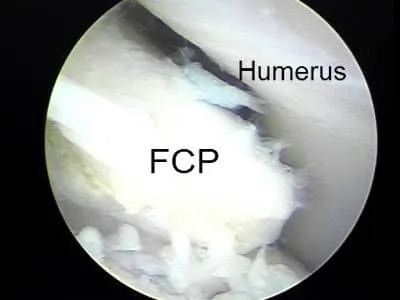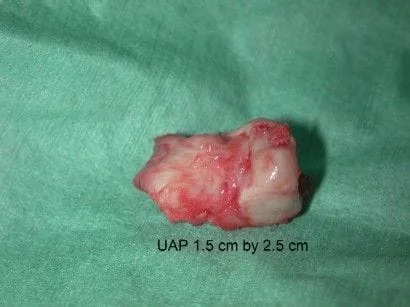Key Points
Elbow dysplasia is a generic term meaning arthritis of the elbow joint
Arthroscopy is a useful modality to both diagnose and treat the underlying cause of elbow dyplasia
Arthroscopy is minimimally invasive surgery, which allows for a quicker recovery
Early treatment will result in the best prognosis
Elbow Dysplasia
- Elbow dysplasia can cause lameness in young large-breed dogs and is commonly found in both elbows.
- Elbow dysplasia is a generic term meaning arthritis in the elbow joint.
- There are four developmental causes of elbow arthritis in dogs:
- osteochondritis dessicans, ununited anconeal process, fragmented coronoid process, and elbow incongruency.
- The photo below of a dog’s elbow shows the three bones that make up the joint: radius, ulna and humerus. The humerus bone has been separated from the radius and the ulna bone in this photo to reveal the three problems within the joint. The red painted regions on the specimen denote the location of osteochondritis dessicans of the lower part of the humerus bone (labeled OCD), fragmented coronoid process (labeled FCP) and an ununited anconeal process (UAP).

- Osteochondritis dissecans (OCD)
- OCD is a condition in which a piece of cartilage becomes partially or fully detached from the surface of the elbow joint. This results in inflammation of the lining of the joint and pain. Below in this photo an intraoperative open approach shows the OCD flap (labeled OCD); with the advent of arthroscopic surgery in our practice, we rarely do an open approach to remove the OCD flaps in dogs.

- Fragmented medial coronoid process
- Fragmented medial coronoid process is a condition in which a small piece of bone on the inner side of the joint has broken off of the ulna bone. This piece of bone irritates the lining of the joint and grinds off the cartilage of the adjacent humerus (similar to having a pebble in your shoe). In the photo below is a large fragmented coronoid process (labeled FCP) as seen at the time of arthroscopy.

- Ununited anconeal process
- Ununited anconeal process is a condition in which a fragment of bone on the back side of the joint has failed to unite with the ulna bone during growth. Normally this bony process fuses with the ulna bone by 20 weeks of age. The breeds most commonly affected include German Shepherds, Bassets, Mastiffs, and St. Bernards. In the photo below the ununited anconeal process (labeled UAP) is clearly visible on the radiograph; the black line (labeled L) in the bone is the cardinal sign that an UAP is present.

- In the photo below, a large ununited anconeal process from the from the dog whose radiograph is just above

- Elbow incongruency
- Elbow incongruency is a condition in which the joint does not have perfect conformation, and the cartilage of the joint wears out rapidly. In simple terms the joint does not fit together well and the final result is progressive arthritis.
Diagnosis
- X-rays of the elbow joint will allow us to make a diagnosis of ununited anconeal process and sometimes OCD and fragmented coronoid process.
- CT scan is more accurate at arriving at a definitive diagnosis than plain x-rays, but has a 15% margin of error.
- If we have an index of suspicion of a fragmented coronoid or OCD we usually recommend diagnostic arthroscopy as it is minimally invasive and these conditions can be then treated at the same time.
Treatment
- Arthroscopic surgery is used to treat OCD and fragmented coronoid processes. This technique allows us to treat the lesions more accurately and allows us to examine more of the joint. Because it is minimally invasive, the patients recover much quicker and have less pain.
- Usually we can successfully remove the offending loose pieces from the joint using arthroscopic surgery, however if we are unsuccessful, a small incision is made on the inner side of the elbow. If your pet has an ununited anconeal process, arthroscopy of the joint is recommended to rule out a concurrent fragmented coronoid. Because an ununited anconeal process is fairly large, it is removed via a small incision made on the outer (lateral) side of the elbow joint.
Convalescence period
- If arthroscopic surgery is done, most pets will be using the limb on the day of surgery.
- By 2 weeks after surgery the lameness is mild.
- By 2 to 3 months after surgery, your pet should be using the limb well.
- Recovery can be somewhat variable from one pet to another.
Success rates
- Most of the dogs with ununited anconeal process will be helped with surgery (about 60% return to normal function, 30% are improved, and 10% do not improve with surgery).
- Approximately 75% of the dogs with having a fragmented coronoid process or OCD of the elbow will be helped with surgery. Unfortunately, surgery will not remove the arthritis that is already present in the joint. As a result, some pets may have some stiffness of the limb or lameness after very heavy exercise or during weather changes (cool damp conditions).
- Dogs that have dramatically swollen elbows prior to surgery tend to be have a lower success rate.
Complications
- Anesthetic death is an uncommon complication.
- One complication is infection of the surgical site, but this complication is uncommon.
- Unresolved lameness may be due to elbow arthritis.
Postop care
- Monitor the stab incisions for signs of infection, which include signs of swelling, redness, pain, yellow or green discharge.
- During the first 6 to 8 weeks after surgery, activity is restricted to short leash walks outside. Running, jumping, and rough play are forbidden.
- After 8 weeks of rest, the activity can be gradually increased over the next two months.


